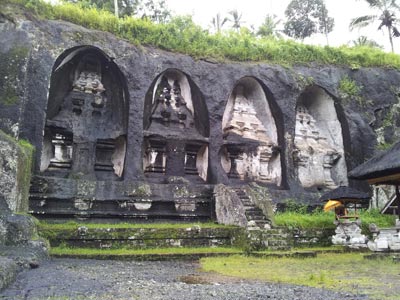
Like China, Bali has these temples carved on the granite side of a mountain. China’s are however Buddhist while Bali’s are Hindu. It is advisable to read up on Hinduism and the sacred texts and epics — Mahabharata, Ramayana, Upanishads. If you have no familiarity with the literature, you’ll probably miss a lot when you travel to Bali. Photo taken by KJ Lau of HK who said it was the cliff at Elephant Temple. I do not know if it was Gunung Kawi Royal Monument or Pura Tirta Empul. I visited the temple with Nikolay and Marina, but my camera battery was discharged. Marina promised to send me her photos when she gets back to Russia in March.
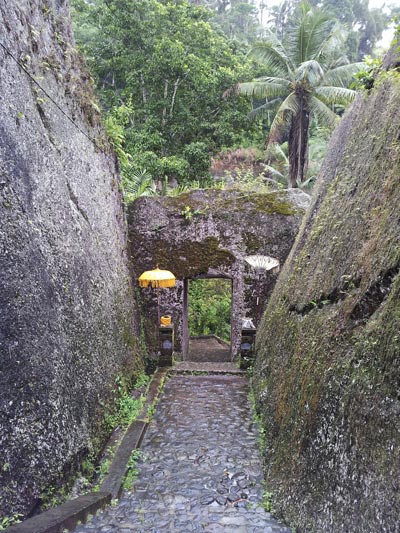
There are 350-odd steps, so you need strong legs. I do not know if climbing the steps would earn you forgiveness or merits as in the Batu Caves of Kuala Lumpur, Malaysia. Bring joss sticks to light at the different altars in the temple.
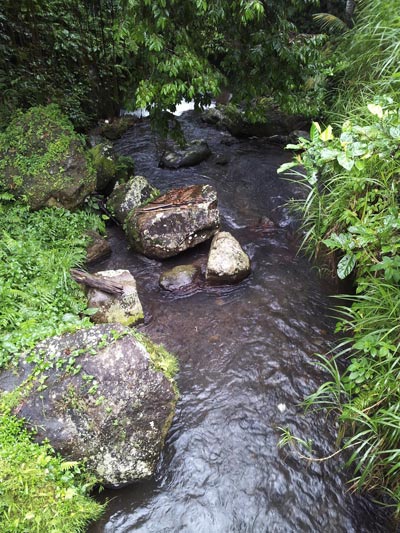
The river runs through the complex. Bring a bottle to fill with the water: it is considered healing and sacred. Like Mount Banahaw, the holy moutain in the Philippines, pilgrims take the water home to bless the house, friends and relatives.
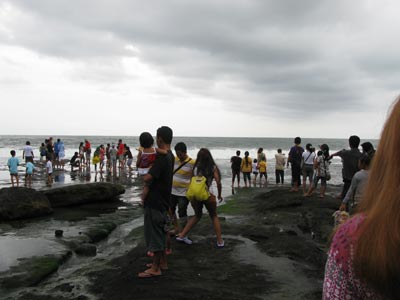
Pura Tanah Lot. There is a temple complex by the shore. When this photo was taken, the tide was high and multitudes of pilgrims (and tourists) arrived to celebrate the festival of Shiva.
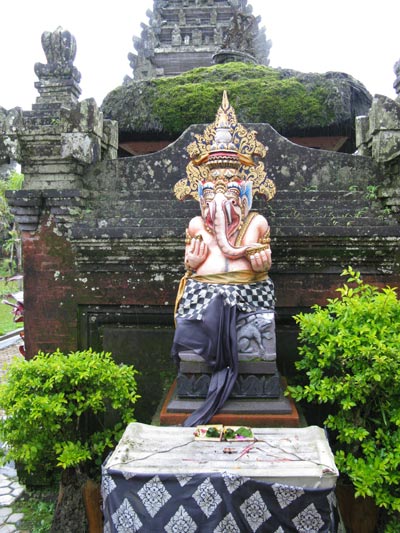
Ganesha, the elephant god, often sits at the entrance and gates of temples and buildings and houses. The god of beginnings, initiations and the arts, Ganesha has a rather complicated history: how he got to have an elephant head and trunk, multiple arms and different functions, etc. and why he is one of the foremost icons in the pantheon. In different cultures, there are different representations of the gods/goddesses in the pantheon. In Egypt, Hathor is represented as human with the ears of a cow depicting her as the symbol of nurture, fertility and motherhood.
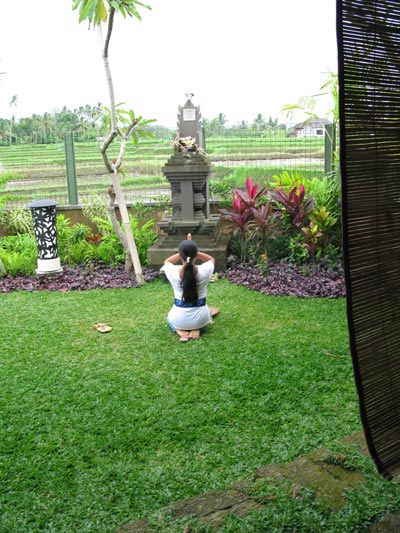
Man Sri was our help. She shopped in the market for grocery — duck, chicken, pork loin, banana, avocado, mango, mangosteen and other necessities — and cooked. She learned how to use the ginseng/renshen and wolfberries/gu ci zi I brought from the US. A few times I got her to buy fresh durian and when its distinctive perfume suffused the kitchen, she helped me eat it. Balinese durian, smaller than the Thai, was the best I have ever tasted anywhere. Durian aficionados seek it and brag about its texture and flavor. Man Sri and I sat in the terrace and chatted. She talked about village life, her personal history, and karma. From the nearby village, the music of the gamelan would drift in through the afternoon silence.
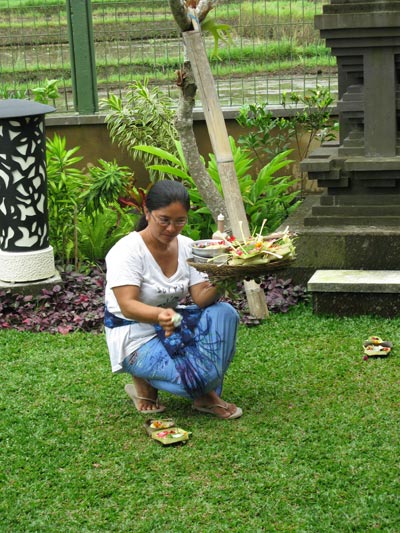
Every morning, Man Sri carried a basket of flowers, steamed rice, rice wine, and fruits, offerings to the land, the gods and goddesses, and the ancestors, and I would see her transformed into a high priestess, her long black hair flowing down the small of her back, belted with a sash and a colorful sarong wrapped around her waist, and she would sprinkle the rice wine around her, go on her knees, chant a sutra, and with palms joined together in prayer, raise them over her head. She gave me bottles of wine (rice and coconut) and everybody in the house had a toast just before I left. Sadly, I had to leave them behind. Her husband, a wood carver, made a dragon cane for me in celebration of my 72nd birthday this year of the Water Dragon.
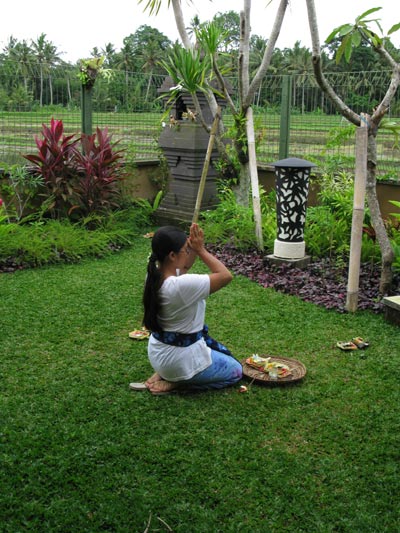
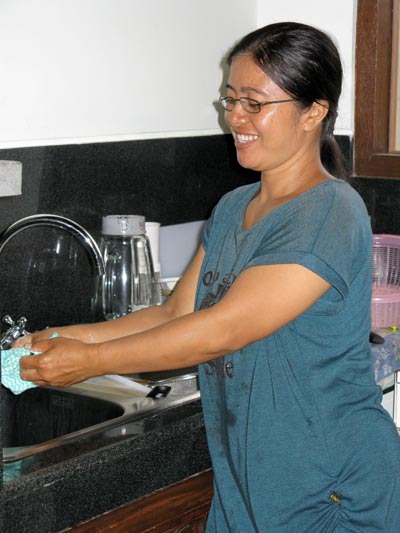
That’s Man Sri in her incarnation as the cook in the kitchen.
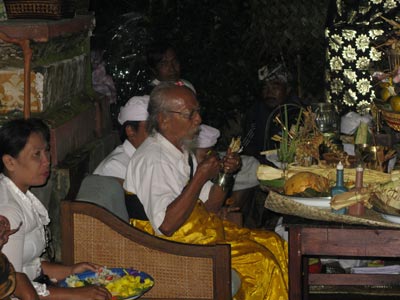
Look at this Hindu priest-shaman-healer. He presides at this initiation attended by a whole community. His voice hardly rises above a whisper but I could hear his chant from a distance. There is something about his presence, a charisma, a mystical aura that captivates his audience and followers. When we arrived, he bowed to us, shook hands and offered a cigarette and a cup of coffee. I bowed to him and kissed his hand (a traditional practice in the Philippines when one meets an old relative). He clasped my hands in both of his, a gesture that characterized our relationship. One night, after a cleansing at another temple, he held my hand, looked into my eyes and surprised me with, “Shantih, shantih, shantih!”
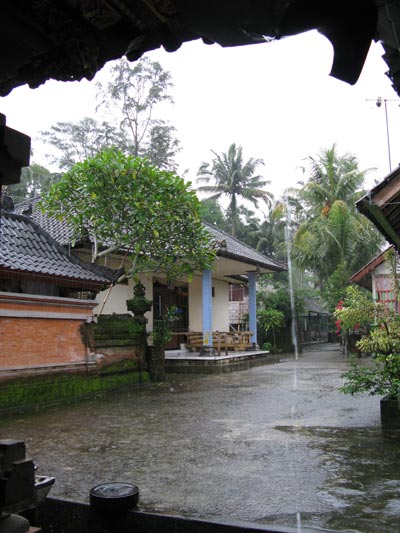
At a courtyard of a small temple in a deserted road about an hour from Ubud, we gathered for an initiation and cleansing. There was a gecko that kept barking every now and then as the shaman chanted, and gave his blessings. Outside, the patter of steady rain and the explosion of an occasional thunder and lightning.
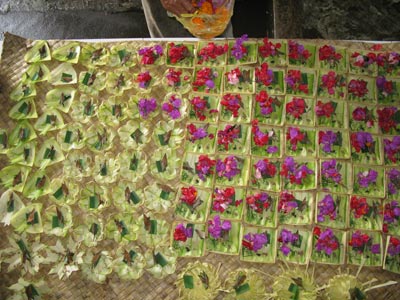
A woman prepares the offerings every day. She weaves a hundred small baskets with coconut leaves, fills them with flowers and food (usually rice). It is a tradition observed religiously everywhere in Bali.

Marina and Nikolay at the crowded entrance to the Pura Tanah Lot Temple (Tanah/Land, Lot/Sea) dedicated to the goddess of the sea Betara Tangah Segara. It was a high holiday in the Hindu world, the Festival of Shiva, and pilgrims and tourists were going to the temples all over the islands. At Pura Tirta Empul, pilgrims were bathing in the spring pool for cleansing, blessing and rejuvenation.
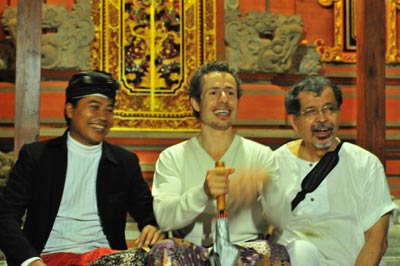
David and Rene with Indonesian disciple at a initiation ceremony.
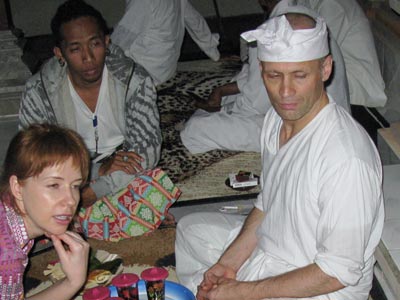
Marina and Pierre at the initiation rituals intently listening to the stories of an Indonesian about a shapeshifter-shaman who could transform himself into an animal, usually an eagle, right before your eyes.
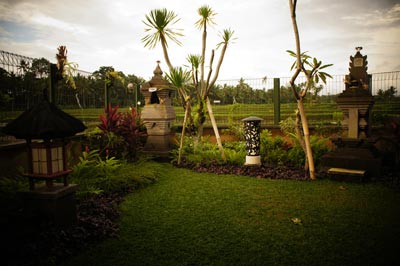
You’ll see them all over town, in front and back of houses and buildings. They are dwelling places for the spirits to rest on their travels. A kind of way station or hospitality homes for the other world.
What an exciting experience KR. I can relate what you feel. It reminds me of my visit to Kumamoto years back with my great Sensei, Takayuki Kubota. Kumamoto is the town where the legendary swordsman, Miyamoto Musashi, spent his last 6 years of his life.
Like you, I can feel their (the warriors) presence when I was there. I’m happy for you KR. Take care.